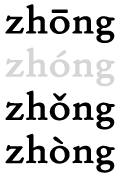 My previous post mentioned that not all tonal permutations exist in the real world. For example, modern standard Mandarin has zhōng, zhǒng, and zhòng, but doesn’t have zhóng. I did not, however, get into any of the reasons for the absence of second-tone zhong.
My previous post mentioned that not all tonal permutations exist in the real world. For example, modern standard Mandarin has zhōng, zhǒng, and zhòng, but doesn’t have zhóng. I did not, however, get into any of the reasons for the absence of second-tone zhong.
Fortunately, my friend James E. Dew, who is much more qualified than I to discuss such fine points of linguistics, was kind enough to send in the explanation below. Jim used to teach the Chinese language and linguistics at the University of Michigan; and for many years he directed the Inter-University Program (a.k.a. the Stanford Center) in Taipei. He is also the author of 6000 Chinese Words: A Vocabulary Frequency Handbook and coauthor of Classical Chinese: A Functional Approach.
Most simply stated, Mandarin syllable shapes with unaspirated occlusive initials and nasal finals don’t occur in second tone. This can be restated a bit less opaquely for those who have not studied Chinese historical phonology, as follows:
Syllables that begin with unaspirated stops b, d, g, or affricates j, zh, z, and end in a nasal n or ng, as a rule don’t have second-tone forms. There are a few exceptions, such as béng (甭 / “needn’t”) and zán (咱 / “we”), which were new words formed by contraction — from búyòng and zámén, respectively — after the tone class split described below took place.
This came about because when Middle Chinese (of Sui-Tang times) píngshēng 平声/平聲 split into yīnpíng 阴平/陰平 (modern Mandarin “first tone”) and yángpíng 阳平/陽平 (M “second tone”), syllables with aspirated initials went into the new yángpíng class, while those with unaspirated initials all fell into the yīnpíng (M first tone) group, thus leaving no unaspirated syllables with nasal finals in the modern Mandarin second tone class.
An interesting corollary to this rule is that among Mandarin “open” syllables (those that end in a vowel) with the above-listed initials, almost all of the second-tone syllables derive from Middle Chinese rùshēng 入声/入聲, and their cognates have stop endings in the southern dialects that preserve rùshēng, as illustrated by the Cantonese examples given below.
| Mandarin | Cantonese | |
|---|---|---|
| 拔 | bá | baht |
| 白 | bái | baahk |
| 薄 | báo | bohk |
| 別/别 | bié | biht |
| 伯 | bó | baak |
| 博 | bó | bok |
| 答 | dá | daap |
| 德 | dé | dāk |
| 敵/敌 | dí | dihk |
| 毒 | dú | duhk |
| 格 | gé | gaak |
| 閣/阁 | gé | gok |
| 國/国 | guó | gwok |
| 急 | jí | gāp |
| 極/极 | jí | gihk |
| 集 | jí | jaahp |
| 夾/夹 | jiá | gaap |
| 結/结 | jié | git |
| 節/节 | jié | jit |
| 菊 | jú | gūk |
| 覺/觉 | jué | gok |
| 決/决 | jué | kyut |
| 雜/杂 | zá | jaahp |
| 澤/泽 | zé | jaahk |
| 閘/闸 | zhá | jaahp |
| 宅 | zhái | jaahk |
| 哲 | zhé | jit |
| 執/执 | zhí | jāp |
| 直 | zhí | jihk |
| 竹 | zhú | jūk |
| 濁/浊 | zhuó | juhk |
